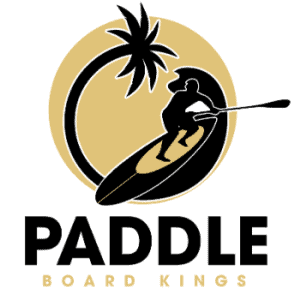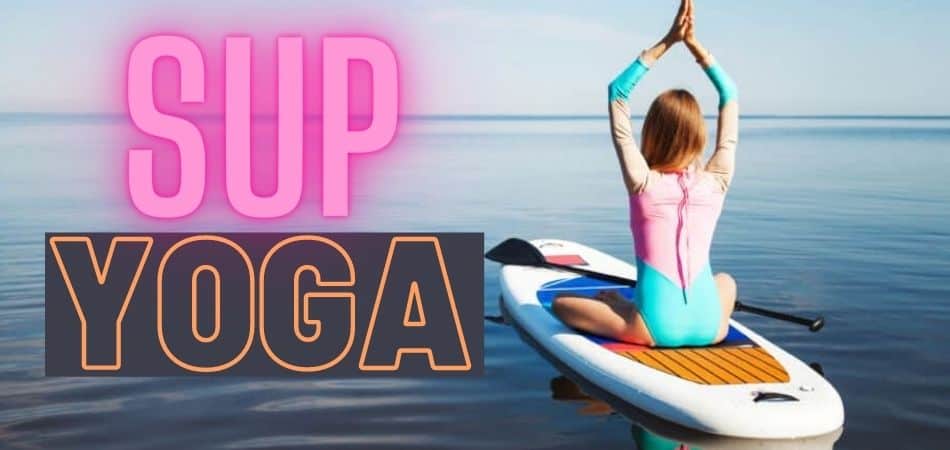
Yoga is a fantastic way to relax, clear your mind, and become more in touch with your body. However, can yoga become even better if you do it on a paddleboard? Let’s see!
Stand-up paddleboarding yoga (SUP yoga) is an incredibly popular pastime for many people. While it might take some getting used to, SUP yoga is a fun, new way for people to increase their balance, outside time, and flexibility. It can be done with roughly any SUP as long as it fits your size.
If you’d like to know more, read on! Below you will find some tips, helpful information, and benefits that should help you decide whether or not you should take up SUP yoga.
The Reasons Behind and Benefits of SUP Yoga
So, can you do yoga on a paddleboard? The answer is yes! If you are new to this, you are probably asking why in the world anybody would want to do yoga on such an imbalanced, wobbly board. The nice thing about this is, you can either join a class or just start practicing on your own! There is really no right or wrong answer. Do what best suits you and what you are the most comfortable with.
There are many benefits of SUP yoga. For starters, it allows experienced yogis to improve their skills. If you have the mindset of a beginner or somebody eager to learn something new, it can greatly enhance the experience and add to your skillset. As long as you approach it with a beginner’s mindset, you will always enjoy it. Additionally, it gives you a great opportunity to work muscles that may otherwise go a bit neglected during land yoga. By working those muscles, you will inevitably become stronger.
Another reason people love SUP yoga is that it greatly increases one’s mindfulness. Because you are resting on a wobbly surface, it requires all your senses to be present. It requires your movements to become very intentional and smooth. This helps you to pay attention to your breathing and every single movement you make. For most people, is an incredibly refreshing way to help their bodies restart.
SUP yoga also provides a way for you to spend time out in nature (which can sometimes be quite difficult). Nothing is nicer than to have a landscape of trees, water, and the song of birds to accompany your yoga sessions. Breathing in fresh air is very invigorating for your body and can help you to stay healthy. Additionally, can you think of a more relaxing setting? The rush of the water is all you need to make your yoga session picture perfect.
SUP yoga has been proven to drastically improve your balance and flexibility. As mentioned before, the wobbly surface forces you to tone your muscles and become increasingly aware of your body and its movements. This will result in an incredible increase in your balance and flexibility. This is quite possibly one of the largest reasons people start doing SUP yoga. You may be shocked at the positive results!
Exercise almost always calms the mind and empowers people. SUP yoga is not an exception to this! The exercise combined with the peaceful, natural atmosphere will invigorate not only your body but your mind and soul as well. It will sharpen your senses and clear away your thoughts. SUP yoga is a fantastic way to remain healthy, both mentally and physically, and maybe even spiritually.
Anchors for SUP Yoga
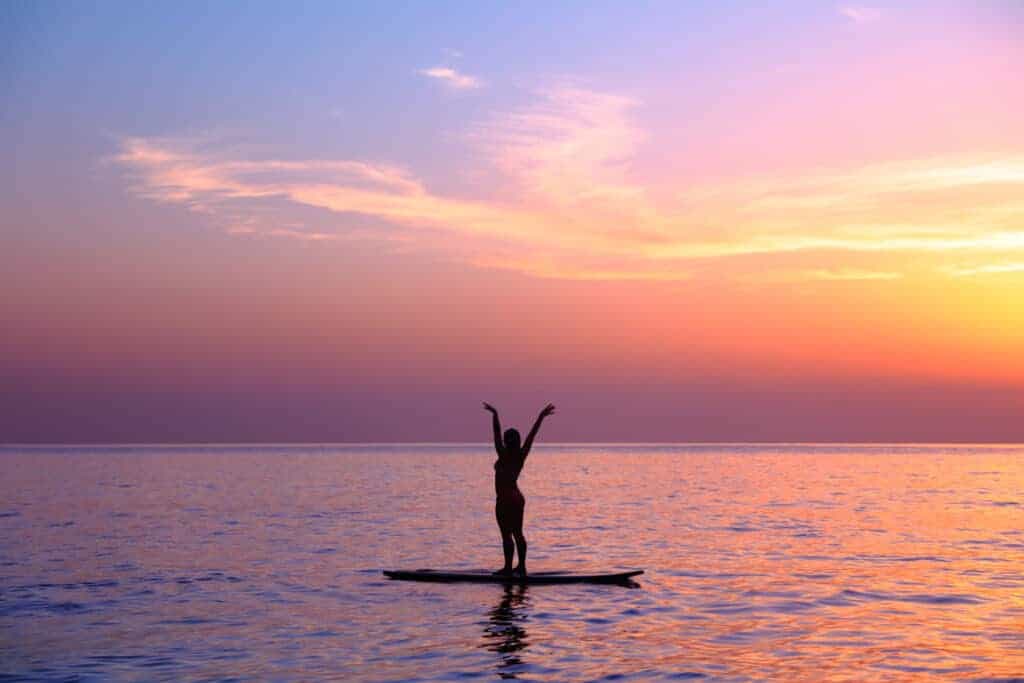
While it is not completely necessary, a paddleboard anchor could very well serve to enhance and convenience your SUP yoga experience. You might set out for a relaxing morning of yoga and meditation only to be constantly interrupted by wind, currents, and strong waves. An anchor will help you to steady your board and make it easier for you to focus on your yoga. Anchors can be bought at most any sporting and outdoor goods store.
When purchasing an anchor, there are a couple of things you should probably consider. Firstly, you will want to take your board’s weight into account. This includes not only the weight of the board but your weight and the weight of your gear as well. An anchor that is neither strong nor big enough will not serve your needs very well. You will also need to account for the depth of the water where you plan to do your yoga. If the anchor’s rope is not long enough, you will be faced with the same problem.
How to Use an Anchor
How you use your anchor depends entirely on which kind of anchor you purchase (there are several).
- The Grapnel Anchor
- The Sandbag Anchor
- The Corkscrew Anchor
- The Mushroom Anchor
First, we have the grapnel anchor. This anchor is easily the most popular type among paddleboarders. It has four foldable prongs that can usually anchor well in both sand and rocks. The grapnel is probably the most sturdy type of anchor and will hold up well in windy conditions. The only downside is that it can easily become badly entangled in thick vegetation.
Next is the sandbag anchor. While this anchor can sometimes be the least reliable, it is also popular and common due to its ease of use. It is portable and can easily be brought out to the middle of the lake or wherever you choose to do your yoga. The problem with the sandbag is that it does not always hold fast, especially in windy conditions. You will also run the risk of tearing the bag on a rocky bottom or having it simply bounce along the bottom rather than secure your paddleboard.
A corkscrew anchor is designed to be driven into the sand along the shoreline. While the corkscrew anchor is fairly secure, it does limit your maneuverability a tad. You will be unable to reach deep water and you will stay completely tied to the shoreline. Of course, if deep water makes you nervous and you would prefer to stay closer to shore, this anchor will be a perfect fit for you.
Finally, we have the mushroom anchor. This anchor is fairly reliable with a soft or sandy bottom because it has smooth edges and will not tangle easily in vegetation. It is also far less likely to scratch your paddleboard because of its smooth edges. This makes it very easy to transport as well. Unfortunately, it is not very reliable with a rocky bed because it cannot grip the bottom. This means it can also slip easily in windy conditions.
Using a paddleboard anchor is a piece of cake. Usually, it works best if you have a carabiner attached to your paddleboard with which to secure the anchor’s rope (make sure you consider the wind and direction of the current before you throw the anchor). Toss the anchor overboard just slightly upstream from where you’d ideally like to be. Allow the rope to run completely through your fingers, then, when positioned perfectly, begin your yoga!
SUP Yoga Gear
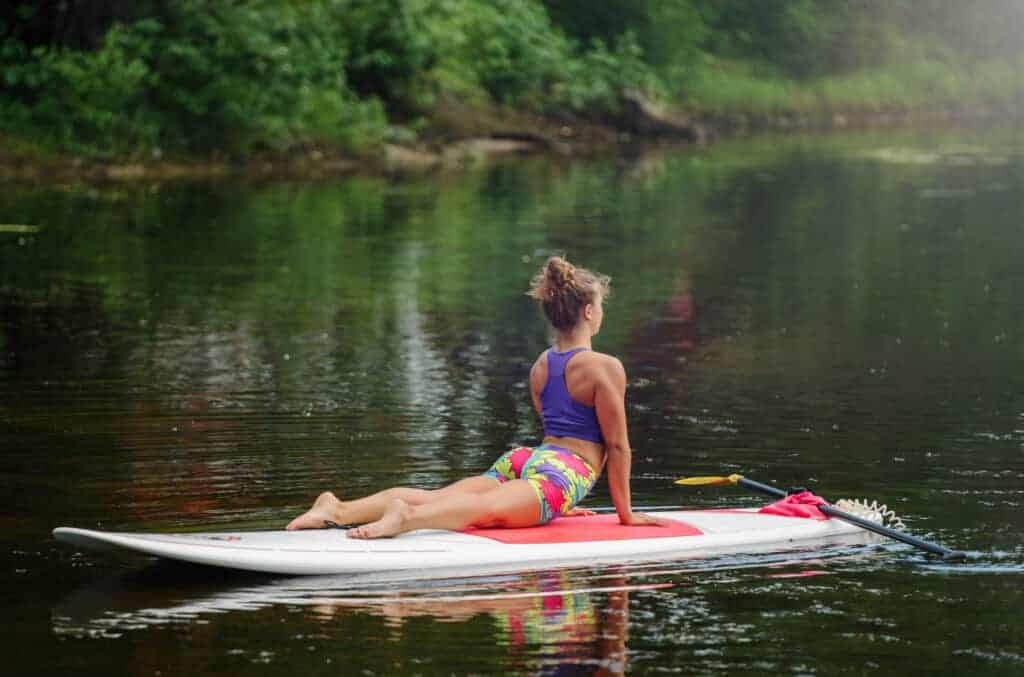
Now that you have an idea of what kind of anchor you need, let’s talk about the gear you will need to begin your SUP yoga. First and foremost, you will obviously need your board and paddle. There are advantages to using paddleboards made specifically for SUP yoga, but usually an inflatable one will serve your needs just as well. Yoga paddleboards tend to be built a little wider on both ends for added stability.
They also often come with a soft-padded deck, which makes slipping less of a likelihood. These paddleboards are designed to be a bit slower but also wider and far more balanced. Again, it is not necessary to invest in one of these boards, but it does have its benefits, especially if you are a beginner and would feel more comfortable with a less wobbly board.
As mentioned above, an anchor is not necessary either, but it sure does make a difference in your yoga experience. The anchor will keep your paddleboard from slipping and sliding too much with the waves and the wind. Even on calm waters, your paddleboard will undoubtedly be moved around with the currents, and that can easily upset your balance. You will have to play around with anchors and rope length before reaching your ideal setting, but having an anchor is well worth it. You will, of course, need to take the weight of the anchor and your board into account. An anchor that is too light will not get the job done.
Before setting out for some SUP yoga, keep in mind that you will likely get wet, so wearing anything made of cotton is probably a bad idea. It is best to either wear a rashguard, other swimwear, or fast-drying yoga clothing to your yoga session. Taking sunglasses, sunblock and a hat is also a good idea to prevent too much sun exposure. Of course, you can wear whatever you are comfortable in, but something flexible and somewhat waterproof is probably your best bet. It is easiest to go barefoot; this will ensure maximum relaxation and comfort.
Popular Poses
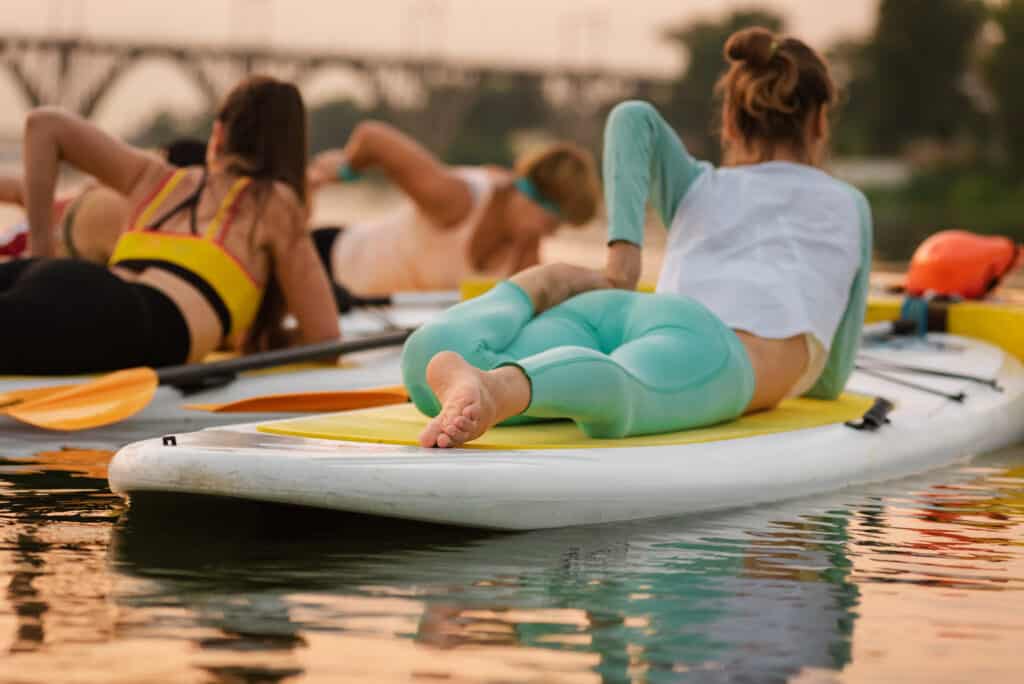
As mentioned before, you do not necessarily have to be a part of a yoga class to get started. Here are a few popular and easy poses that you can give a try!
Easy Pose Sukhasana
The Sukhasana is a very simple pose. Sit facing the front of your board and cross your legs. Next, place your hands on your knees with your palms facing down. Once you have balanced your weight evenly, close your eyes, take deep breaths, and focus on your surroundings as much as you can. Pay attention to the rocking movements of the board and the sound of the water around you. Allow yourself to relax and soak it all in.
Downward Dog
You will probably recognize this pose as one of the more common yoga poses out there. With both hands and feet on the board, slowly bend your legs and hips back until your legs are completely straight and your head is facing down. Take a few moments to take in the horizon behind you and breathe deeply. You can make a few organic movements until you are settled into the pose. Make sure your thumbs and index fingers are firmly planted to protect your wrist.
Plank
Plank is actually the transition move out of the downward dog. Slowly and carefully shift your weight forward. Keep your legs straight and keep moving forward until your shoulders are stacked above your wrists. From the crown of your head to your heels, create a long line and engage the lower belly. If you can do so, lift one leg at a time. If needed, you can also rest your knees to make it a tad easier.
Cobra/Upward-Facing Dog
You may also recognize cobra (aka upward-facing dog) as well. It is the exact opposite of downward dog and will give your back and leg muscles a good stretch. For this pose, lie prone on your stomach then slowly raise your upper body and pull your elbows in toward each other. Inhale carefully and lift your head, chest, and shoulders.
Child’s Pose Balasana
As the name suggests, Child’s Pose Balasana is also a beginner’s pose. It is also an excellent resting pose. Make sure your stomach is resting near the center of your board. Either extend your arms in front of you or even behind you. Keep your knees apart and let your forehead come to rest on the board. Breathe deeply and relax.
Tips for Beginners
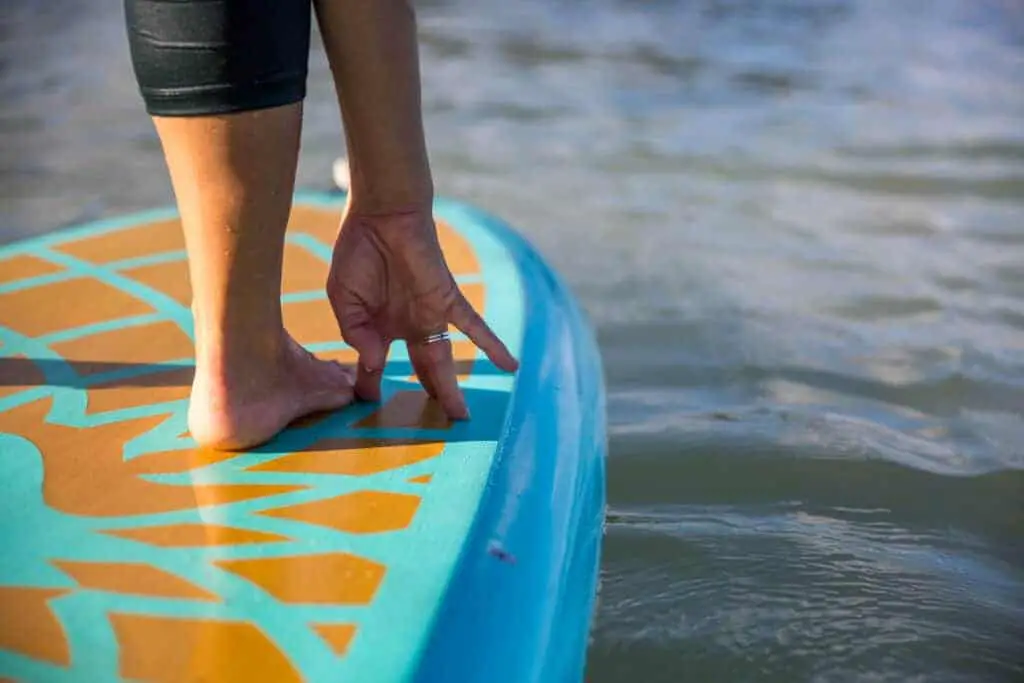
If you are a SUP Yoga beginner, you may want to know a couple of tips. Make sure you launch your board in no deeper than knee-deep water. You do not want to launch too close to the shore because the fin might catch on the bottom. Additionally, you should take the time to find a correct and comfortable hand and knee position. Remain on your knees until you are comfortable standing up on the board.
Start with some easy poses, ones that won’t throw your balance off too much and don’t require anything crazy. Sometimes it helps if you bring a friend or two to help you begin. It’s always a lot more fun to do yoga with a few friends.
